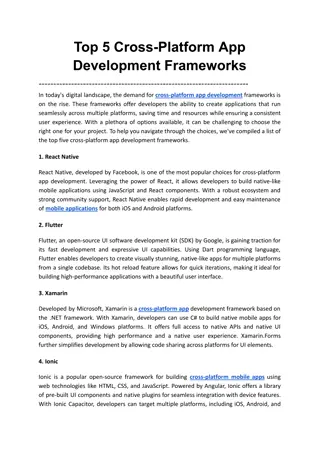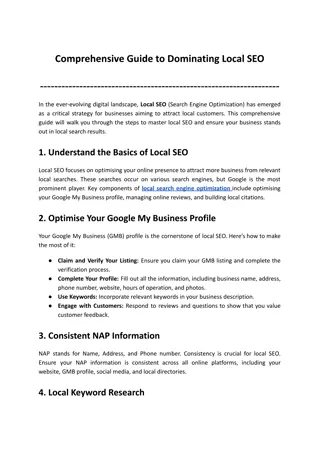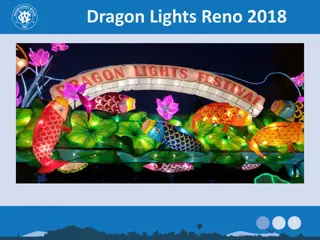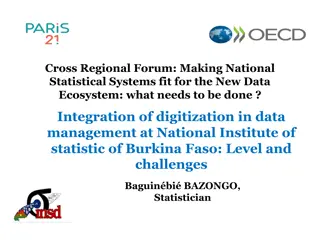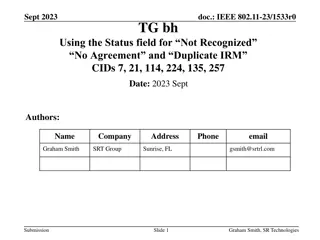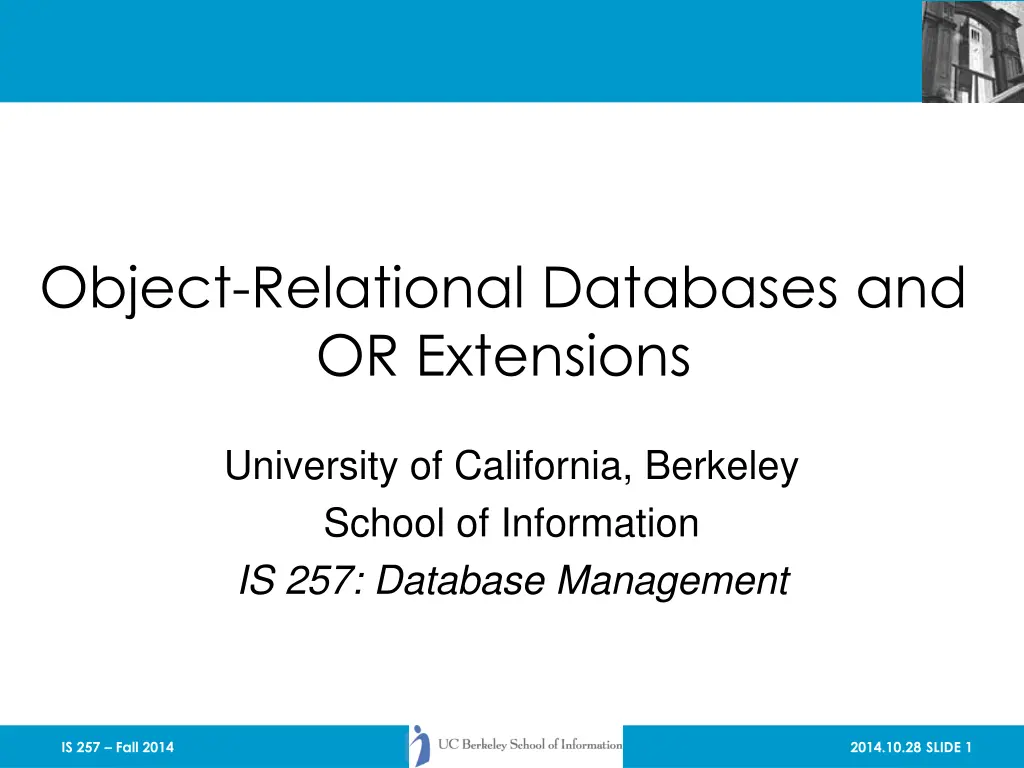
Object-Relational Databases: Features and Evolution at UC Berkeley
Explore the evolution and features of Object-Relational Databases in this informative lecture series at the University of California, Berkeley. Delve into OR features in Oracle, MySQL, and PostgreSQL, user-defined datatypes and functions, and the background of OR databases. Learn about the fusion of object-oriented and relational systems and the extended SQL capabilities in an illustrative manner.
Download Presentation

Please find below an Image/Link to download the presentation.
The content on the website is provided AS IS for your information and personal use only. It may not be sold, licensed, or shared on other websites without obtaining consent from the author. If you encounter any issues during the download, it is possible that the publisher has removed the file from their server.
You are allowed to download the files provided on this website for personal or commercial use, subject to the condition that they are used lawfully. All files are the property of their respective owners.
The content on the website is provided AS IS for your information and personal use only. It may not be sold, licensed, or shared on other websites without obtaining consent from the author.
E N D
Presentation Transcript
Object-Relational Databases and OR Extensions University of California, Berkeley School of Information IS 257: Database Management IS 257 Fall 2014 2014.10.28 SLIDE 1
Lecture Outline Object-Relational DBMS OR features in Oracle and MySQL Functions and Triggers OR features in PostgreSQL Extending OR databases (examples from PostgreSQL) IS 257 Fall 2014 2014.10.28 SLIDE 2
Lecture Outline Object-Relational DBMS OR features in Oracle and MySQL Functions and Triggers OR features in PostgreSQL Extending OR databases (examples from PostgreSQL) IS 257 Fall 2014 2014.10.28 SLIDE 3
Object Relational Databases Background Object Definitions inheritance User-defined datatypes User-defined functions IS 257 Fall 2014 2014.10.28 SLIDE 4
Object Relational Databases Began with UniSQL/X unified object-oriented and relational system Some systems (like OpenODB from HP) were Object systems built on top of Relational databases Postgres project at Berkeley Miro/Montage/Illustra built on Postgres. Informix Buys Illustra. (DataBlades) Oracle Hires away Informix Programmers. (Cartridges) Informix bought by IBM (you can still get it). IS 257 Fall 2014 2014.10.28 SLIDE 5
Object Relational Data Model Class, instance, attribute, method, and integrity constraints OID per instance Encapsulation Multiple inheritance hierarchy of classes Class references via OID object references Set-Valued attributes Abstract Data Types IS 257 Fall 2014 2014.10.28 SLIDE 6
Object Relational Extended SQL (Illustra) CREATE TABLE tablename {OF TYPE Typename}|{OF NEW TYPE typename} (attr1 type1, attr2 type2, ,attrn typen) {UNDER parent_table_name}; CREATE TYPE typename (attribute_name type_desc, attribute2 type2, , attrn typen); CREATE FUNCTION functionname (type_name, type_name) RETURNS type_name AS sql_statement IS 257 Fall 2014 2014.10.28 SLIDE 7
Object-Relational SQL in ORACLE CREATE (OR REPLACE) TYPE typename AS OBJECT (attr_name, attr_type, ); CREATE TABLE OF typename; IS 257 Fall 2014 2014.10.28 SLIDE 8
Example CREATE TYPE ANIMAL_TY AS OBJECT (Breed VARCHAR2(25), Name VARCHAR2(25), Birthdate DATE); Creates a new type CREATE TABLE Animal of Animal_ty; Creates Object Table IS 257 Fall 2014 2014.10.28 SLIDE 9
Constructor Functions INSERT INTO Animal values (ANIMAL_TY( Mule , Frances , TO_DATE( 01-APR-1997 , DD-MM- YYYY ))); Insert a new ANIMAL_TY object into the table, i.e., the type name is a constructor IS 257 Fall 2014 2014.10.28 SLIDE 10
Selecting from an Object Table Just use the columns in the object SELECT Name from Animal; IS 257 Fall 2014 2014.10.28 SLIDE 11
More Complex Objects CREATE TYPE Address_TY as object (Street VARCHAR2(50), City VARCHAR2(25), State CHAR(2), zip NUMBER); CREATE TYPE Person_TY as object (Name VARCHAR2(25), Address ADDRESS_TY); CREATE TABLE CUSTOMER (Customer_ID NUMBER, Person PERSON_TY); IS 257 Fall 2014 2014.10.28 SLIDE 12
What Does the Table Look like? DESCRIBE CUSTOMER; NAME TYPE ----------------------------------------------------- CUSTOMER_ID NUMBER PERSON NAMED TYPE IS 257 Fall 2014 2014.10.28 SLIDE 13
Inserting INSERT INTO CUSTOMER VALUES (1, PERSON_TY( John Smith , ADDRESS_TY( 57 Mt Pleasant St. , Finn , NH , 111111))); IS 257 Fall 2014 2014.10.28 SLIDE 14
Selecting from Abstract Datatypes SELECT Customer_ID from CUSTOMER; SELECT * from CUSTOMER; CUSTOMER_ID PERSON(NAME, ADDRESS(STREET, CITY, STATE ZIP)) --------------------------------------------------------------------------------------------------- 1 PERSON_TY( JOHN SMITH , ADDRESS_TY( 57... IS 257 Fall 2014 2014.10.28 SLIDE 15
Selecting from Abstract Datatypes SELECT Customer_id, person.name from Customer; SELECT Customer_id, person.address.street from Customer; IS 257 Fall 2014 2014.10.28 SLIDE 16
Updating UPDATE Customer SET person.address.city = HART where person.address.city = Briant ; IS 257 Fall 2014 2014.10.28 SLIDE 17
MySQL So far, no data type definitions in MySQL But would not be surprised to see them before too long There are already spatial extensions and types User-defined data types are in the current SQL standard, so they will probably make it into MySQL eventually But user-defined functions and triggers are in MySQL IS 257 Fall 2014 2014.10.28 SLIDE 18
User-Defined Functions (Oracle) CREATE [OR REPLACE] FUNCTION funcname (argname [IN | OUT | IN OUT] datatype ) RETURN datatype (IS | AS) {block | external body} IS 257 Fall 2014 2014.10.28 SLIDE 19
Example Create Function BALANCE_CHECK (Person_name IN Varchar2) RETURN NUMBER is BALANCE NUMBER(10,2) BEGIN SELECT sum(decode(Action, BOUGHT , Amount, 0)) - sum(decode(Action, SOLD , amount, 0)) INTO BALANCE FROM LEDGER where Person = PERSON_NAME; RETURN BALANCE; END; IS 257 Fall 2014 2014.10.28 SLIDE 20
Example Select NAME, BALANCE_CHECK(NAME) from Worker; Would return the name and balance for each worker IS 257 Fall 2014 2014.10.28 SLIDE 21
Functions and Procedures - MySQL CREATE [DEFINER = { user | CURRENT_USER }] PROCEDUREsp_name ([proc_parameter[,...]]) [characteristic ...] routine_body CREATE [DEFINER = { user | CURRENT_USER }] FUNCTIONsp_name ([func_parameter[,...]]) RETURNS type [characteristic ...] routine_body proc_parameter: [ IN | OUT | INOUT ] param_name type func_parameter:param_nametype type:Any valid MySQL data type characteristic: LANGUAGE SQL | [NOT] DETERMINISTIC | { CONTAINS SQL | NO SQL | READS SQL DATA | MODIFIES SQL DATA } | SQL SECURITY { DEFINER | INVOKER } | COMMENT 'string' routine_body:Valid SQL procedure statement IS 257 Fall 2014 2014.10.28 SLIDE 22
Defining a MySQL procedure mysql> delimiter // mysql> CREATE PROCEDURE simpleproc (OUT param1 INT) -> BEGIN -> SELECT COUNT(*) INTO param1 FROM t; -> END// Query OK, 0 rows affected (0.00 sec) mysql> delimiter ; mysql> CALL simpleproc(@a); Query OK, 0 rows affected (0.00 sec) mysql> SELECT @a; +------+ | @a | +------+ | 3 | +------+ 1 row in set (0.00 sec) IS 257 Fall 2014 2014.10.28 SLIDE 23
Defining a MySQL Function mysql> CREATE FUNCTION hello (s CHAR(20)) RETURNS CHAR(50) DETERMINISTIC -> RETURN CONCAT('Hello, ',s,'!'); Query OK, 0 rows affected (0.00 sec) mysql> SELECT hello('world'); +----------------+ | hello('world') | +----------------+ | Hello, world! | +----------------+ 1 row in set (0.00 sec) DETERMINISTIC means the function always produces the same result for the same input parameters IS 257 Fall 2014 2014.10.28 SLIDE 24
TRIGGERS (Oracle) Create TRIGGER UPDATE_LODGING INSTEAD OF UPDATE on WORKER_LODGING for each row BEGIN if :old.name <> :new.name then update worker set name = :new.name where name = :old.name; end if; if :old.lodging <> etc... IS 257 Fall 2014 2014.10.28 SLIDE 25
Triggers in MySQL CREATE [DEFINER = { user | CURRENT_USER }] TRIGGER trigger_name trigger_time trigger_event ON tbl_name FOR EACH ROW trigger_stmt trigger_event can be INSERT, UPDATE, or DELETE trigger_time can be BEFORE or AFTER. IS 257 Fall 2014 2014.10.28 SLIDE 26
Triggers in MySQL CREATE TABLE test1(a1 INT); CREATE TABLE test2(a2 INT); CREATE TABLE test3(a3 INT NOT NULL AUTO_INCREMENT PRIMARY KEY); CREATE TABLE test4( a4 INT NOT NULL AUTO_INCREMENT PRIMARY KEY, b4 INT DEFAULT 0 ); delimiter | CREATE TRIGGER testref BEFORE INSERT ON test1 FOR EACH ROW BEGIN INSERT INTO test2 SET a2 = NEW.a1; DELETE FROM test3 WHERE a3 = NEW.a1; UPDATE test4 SET b4 = b4 + 1 WHERE a4 = NEW.a1; END | delimiter ; IS 257 Fall 2014 2014.10.28 SLIDE 27
Triggers in MySQL (cont) mysql> INSERT INTO test3 (a3) VALUES (NULL), (NULL), (NULL), (NULL), (NULL), (NULL), (NULL), (NULL), (NULL), (NULL); mysql> INSERT INTO test4 (a4) VALUES (0), (0), (0), (0), (0), (0), (0), (0), (0), (0); mysql> INSERT INTO test1 VALUES -> (1), (3), (1), (7), (1), (8), (4), (4); mysql> SELECT * FROM test1; +------+ | a1 | +------+ | 1 | | 3 | | 1 | | 7 | | 1 | | 8 | | 4 | | 4 | +------+ IS 257 Fall 2014 2014.10.28 SLIDE 28
Triggers in MySQL (cont.) mysql> SELECT * FROM test2; +------+ | a2 | +------+ | 1 | | 3 | | 1 | | 7 | | 1 | | 8 | | 4 | | 4 | +------+ mysql> SELECT * FROM test3; +----+ | a3 | +----+ | 2 | | 5 | | 6 | | 9 | | 10 | +----+ mysql> SELECT * FROM test4; +----+------+ | a4 | b4 | +----+------+ | 1 | 3 | | 2 | 0 | | 3 | 1 | | 4 | 2 | | 5 | 0 | | 6 | 0 | | 7 | 1 | | 8 | 1 | | 9 | 0 | | 10 | 0 | +----+------+ IS 257 Fall 2014 2014.10.28 SLIDE 29
Triggers in SQLite IS 257 Fall 2014 2014.10.28 SLIDE 30
Lecture Outline Object-Relational DBMS OR features in Oracle and MySQL OR features in PostgreSQL Extending OR databases (examples from PostgreSQL) IS 257 Fall 2014 2014.10.28 SLIDE 31
PostgreSQL Derived from POSTGRES Developed at Berkeley by Mike Stonebraker and his students (EECS) starting in 1986 Postgres95 Andrew Yu and Jolly Chen adapted POSTGRES to SQL and greatly improved the code base PostgreSQL Name changed in 1996, and since that time the system has been expanded to support all SQL standard features, plus unique extensions IS 257 Fall 2014 2014.10.28 SLIDE 32
PostgreSQL Classes The fundamental notion in Postgres is that of a class, which is a named collection of object instances. Each instance has the same collection of named attributes, and each attribute is of a specific type. Furthermore, each instance has a permanent object identifier (OID) that is unique throughout the installation. Because SQL syntax refers to tables, we will use the terms table and class interchangeably. Likewise, an SQL row is an instance and SQL columns are attributes. IS 257 Fall 2014 2014.10.28 SLIDE 33
Creating a Class You can create a new class by specifying the class name, along with all attribute names and their types: CREATE TABLE weather ( city varchar(80), temp_lo int, -- low temperature temp_hi int, -- high temperature prcp real, -- precipitation date date ); IS 257 Fall 2014 2014.10.28 SLIDE 34
PostgreSQL Postgres can be customized with an arbitrary number of user-defined data types. Consequently, type names are not syntactical keywords, except where required to support special cases in the SQL92 standard. So far, the Postgres CREATE command looks exactly like the command used to create a table in a traditional relational system. However, we will presently see that classes have properties that are extensions of the relational model. IS 257 Fall 2014 2014.10.28 SLIDE 35
PostgreSQL All of the usual SQL commands for creation, searching and modifying classes (tables) are available. With some additions Inheritance Non-Atomic Values User defined functions and operators IS 257 Fall 2014 2014.10.28 SLIDE 36
Inheritance CREATE TABLE cities ( name text, population float, altitude int -- (in ft) ); CREATE TABLE capitals ( state char(2) ) INHERITS (cities); IS 257 Fall 2014 2014.10.28 SLIDE 37
Inheritance ray=# create table cities (name varchar(50), population float, altitude int); CREATE TABLE ray=# \d cities Table "public.cities" Column | Type | Modifiers ------------+-----------------------+----------- name | character varying(50) | population | double precision | altitude | integer | ray=# create table capitals (state char(2)) inherits (cities); CREATE TABLE ray=# \d capitals Table "public.capitals" Column | Type | Modifiers ------------+-----------------------+----------- name | character varying(50) | population | double precision | altitude | integer | state | character(2) | Inherits: cities IS 257 Fall 2014 2014.10.28 SLIDE 38
Inheritance In Postgres, a class can inherit from zero or more other classes. A query can reference either all instances of a class or all instances of a class plus all of its descendants IS 257 Fall 2014 2014.10.28 SLIDE 39
Inheritance For example, the following query finds all the cities that are situated at an attitude of 500ft or higher: SELECT name, altitude FROM cities WHERE altitude > 500; +----------+----------+ |name | altitude | +----------+----------+ |Las Vegas | 2174 | +----------+----------+ |Mariposa | 1953 | +----------+----------+ IS 257 Fall 2014 2014.10.28 SLIDE 40
Inheritance On the other hand, to find the names of all cities, including state capitals, that are located at an altitude over 500ft, the query is: SELECT c.name, c.altitude FROM cities* c WHERE c.altitude > 500; which returns: +----------+----------+ |name | altitude | +----------+----------+ |Las Vegas | 2174 | +----------+----------+ |Mariposa | 1953 | +----------+----------+ |Madison | 845 | +----------+----------+ IS 257 Fall 2014 2014.10.28 SLIDE 41
Inheritance The "*" after cities in the preceding query indicates that the query should be run over cities and all classes below cities in the inheritance hierarchy Many of the PostgreSQL commands (SELECT, UPDATE and DELETE, etc.) support this inheritance notation using "*" IS 257 Fall 2014 2014.10.28 SLIDE 42
Non-Atomic Values One of the tenets of the relational model is that the attributes of a relation are atomic I.e. only a single value for a given row and column (I.e., 1st Normal Form) Postgres does not have this restriction: attributes can themselves contain sub- values that can be accessed from the query language Examples include arrays and other complex data types. IS 257 Fall 2014 2014.10.28 SLIDE 43
Non-Atomic Values - Arrays Postgres allows attributes of an instance to be defined as fixed-length or variable-length multi- dimensional arrays. Arrays of any base type or user-defined type can be created. To illustrate their use, we first create a class with arrays of base types. CREATE TABLE SAL_EMP ( name text, pay_by_quarter int4[], schedule text[][] ); IS 257 Fall 2014 2014.10.28 SLIDE 44
Non-Atomic Values - Arrays The preceding SQL command will create a class named SAL_EMP with a text string (name), a one-dimensional array of int4 (pay_by_quarter), which represents the employee's salary by quarter and a two-dimensional array of text (schedule), which represents the employee's weekly schedule Now we do some INSERTSs; note that when appending to an array, we enclose the values within braces and separate them by commas. IS 257 Fall 2014 2014.10.28 SLIDE 45
Inserting into Arrays INSERT INTO SAL_EMP VALUES ('Bill', '{10000, 10000, 10000, 10000}', '{{"meeting", "lunch"}, {}}'); INSERT INTO SAL_EMP VALUES ('Carol', '{20000, 25000, 25000, 25000}', '{{"talk", "consult"}, {"meeting"}}'); IS 257 Fall 2014 2014.10.28 SLIDE 46
Querying Arrays This query retrieves the names of the employees whose pay changed in the second quarter: SELECT name FROM SAL_EMP WHERE SAL_EMP.pay_by_quarter[1] <> SAL_EMP.pay_by_quarter[2]; +------+ |name | +------+ |Carol | +------+ IS 257 Fall 2014 2014.10.28 SLIDE 47
Querying Arrays This query retrieves the third quarter pay of all employees: SELECT SAL_EMP.pay_by_quarter[3] FROM SAL_EMP; +---------------+ |pay_by_quarter | +---------------+ |10000 | +---------------+ |25000 | +---------------+ IS 257 Fall 2014 2014.10.28 SLIDE 48
Querying Arrays We can also access arbitrary slices of an array, or subarrays. This query retrieves the first item on Bill's schedule for the first two days of the week. SELECT SAL_EMP.schedule[1:2][1:1] FROM SAL_EMP WHERE SAL_EMP.name = 'Bill'; +-------------------+ |schedule | +-------------------+ |{{"meeting"},{""}} | +-------------------+ IS 257 Fall 2014 2014.10.28 SLIDE 49
Lecture Outline Object-Relational DBMS OR features in Oracle OR features in PostgreSQL Extending OR databases (examples from PostgreSQL) IS 257 Fall 2014 2014.10.28 SLIDE 50

